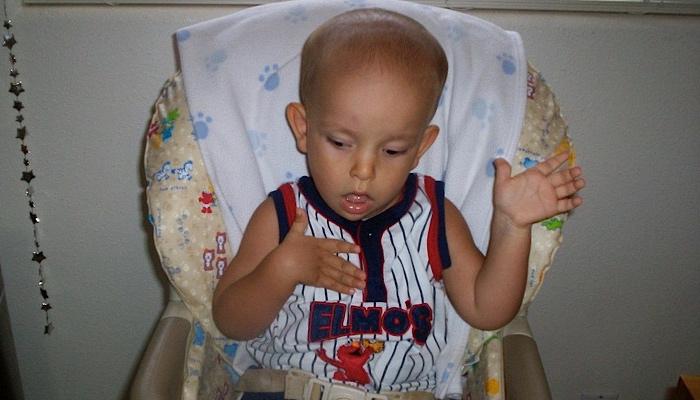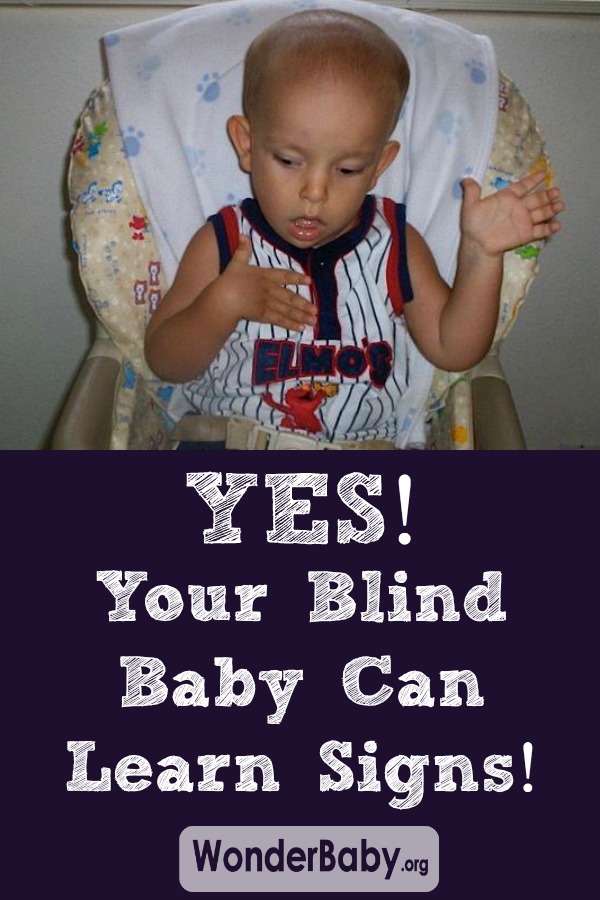Sign Language for Blind Babies

It’s the hot new trend these days… Sign language for hearing babies! The basic idea behind this movement is that very young babies are intelligent enough to communicate, but lack the maturity to control vocalization. Without a means of dependable communication, babies must resort to crying to get their message across.
However, if you teach your baby a few basic signs, like more, eat, and diaper, they can tell you what they need through hand gestures rather than tantrums. And studies show that signing babies learn to talk faster and pick up foreign languages easier when they get older. Amazing!
But can sign language work for blind babies? Signs are made to be very visual, can blind babies really pick them up? We’re here to tell you first hand, YES! Our son, Ivan, began learning signs at about 14 months old and he really took off (in the photo above he is signing “bib” while sitting in his high chair). He learned his first sign, “more,” in less than an hour and once the idea of communication was in his head, there was no stopping him.
Why Sign?
The evidence in support of signing is immense. Here are some reasons why you should consider teaching your baby signs:
- Signs give your baby a way to express themselves before they are verbal.
- Learning more than one language is great for language development.
- Babies who sign will have an earlier understanding of the English language and may learn to speak earlier.
- Babies who sign may possibly have a higher I.Q.
- Signing can lower your baby’s frustration levels because they cancommunicate with you.
- Your baby may even trust you more because he knows that you understand what he is trying to tell you.
For the visually impaired baby, the benefits are even greater:
- Blind children often have problems identifying body parts. Since signs are dependent on the body, they can increase body awareness.
- Similarly, signs can help blind children understand that gestures and movements, otherwise known as body language, can be a form of communication. This can make it easier to teach a blind child that other people can see them.
- Many blind children also have speech delays. teaching them signs early on can help prevent any speech delays.
- Another problem signs can help you avoid are fine motor delays. Signs can improve finger dexterity.
Signing Tips
Here are some simple tips to help you get your baby started signing…
 Begin with an easy sign, like “more.” Play a back-and-forth game with a favorite toy. Every time you have the toy, ask your baby if she wants more, help her make the sign with her hands, then give it to her. I know it sounds incredible, but Ivan picked up this first sign in less than an hour!
Begin with an easy sign, like “more.” Play a back-and-forth game with a favorite toy. Every time you have the toy, ask your baby if she wants more, help her make the sign with her hands, then give it to her. I know it sounds incredible, but Ivan picked up this first sign in less than an hour!- Introduce one sign at a time and try to pick signs that your baby will want to use, like eat, diaper, bib, or ball. Choose signs that are significant to your baby. In the picture to the right, Ivan signs “diaper” right before a diaper change.
- Watch your baby carefully because he will begin to make his own signs. We noticed that every time we were about to put Ivan’s bib around his neck he would place his right hand on his chest and pat his chest with his left hand. We quickly realized that this was Ivan’s sign for “bib.”
 Accommodate your baby’s little hands and fingers by simplifying signs. We aren’t trying to teach our babies American Sign Language, just a private means of communication. Likewise, if your baby adapts a sign to fit their needs better, let them! Ivan, for example, doesn’t put his arm up for the sign “up,” he puts his hand behind his head, but we all know what he means!If you’re looking to teach your child a series of signs for long-term use, then you might want to check out the Canaan Barrie signs system developed for deaf-blind signers.
Accommodate your baby’s little hands and fingers by simplifying signs. We aren’t trying to teach our babies American Sign Language, just a private means of communication. Likewise, if your baby adapts a sign to fit their needs better, let them! Ivan, for example, doesn’t put his arm up for the sign “up,” he puts his hand behind his head, but we all know what he means!If you’re looking to teach your child a series of signs for long-term use, then you might want to check out the Canaan Barrie signs system developed for deaf-blind signers.- The whole idea is that these signs will lead to verbal words and when they do there will be a period where your baby will use both at the same time, but eventually the sign will gradually disappear to be completely replaced by the verbal word. It’s sad to see the signs go, but remember that this is the transition from baby signs to talking.
Have fun with your baby and don’t pressure them to sign. Signing isn’t for everyone! But if your baby does enjoy signing, encourage it with lots of hugs, kisses, and praise. What a wonderful way for your young baby to communicate with you!
Below are some sites and resources that show different baby signs so you can get started signing with your baby, but remember that you can always make up your own signs, too.
- Come Sign with Us
- Talking with Baby
- Signing Baby Dictionary
- Video Dictionary of Signs
- Baby Sign Printables
Read this article in Arabic: قراءة هذا المقال بالعربية

Related Posts

Eye Conditions and Syndromes, Visual Impairment
Neuralink Announces Plans to Restore Sight to the Blind with Brain Chip
Elon Musk’s company Neuralink has announced plans to begin human trials of its new “Blindsight” brain chip by the end of 2025.

Visual Impairment
The Gift of Understanding: How a Young Child Helps His Blind Father Navigate Life
When a parent is blind, it’s natural for people to wonder how their sighted child will adapt. Will they struggle to understand their parent’s needs? Will they feel burdened by...

Braille and Literacy, Toys, Visual Impairment
24 Braille Toys for Kids Who are Blind
Everything from alphabet blocks to raised line coloring pages and activity books to puzzles to card and board games... and so much more! And it's all in braille ready for...